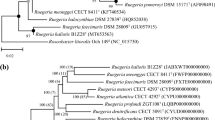Abstract
A novel Gram-negative and rod-shaped bacterium, designated N8T, was isolated from tidal flat sediment. Phylogenetic analysis based on 16S rRNA gene sequences showed that N8T strain is associated with the family Phyllobacteriaceae: two uncultured clones (98.4 and 99.8% 16S rRNA gene sequence similarity) and the genus Mesorhizobium (≤97.0%). The novel strain formed a separate clade with uncultured clones in the phylogenetic tree based on 16S rRNA gene sequences. Cellular fatty acid profiles predominately comprised C18:1 ω7c and C19:0 cyclo ω8c. The major isoprenoid quinone is ubiquinone-10 and genomic DNA G+C content is 53.4 mol%. The polyphasic taxonomic study indicates that the novel strain N8T represents a novel species of the new genus in the family Phyllobacteriaceae, named Aliihoeflea aestuarii. The type strain is N8T (= KCTC 22052T= JCM 15118T= DSM 19536T).
Similar content being viewed by others
References
An, D.S., W.T. Im, H.C. Yang, and S.T. Lee. 2006. Shinella granuli gen. nov., sp. nov., and proposal of the reclassification of Zoogloea ramigera ATCC 19623 as Shinella zoogloeoides sp. nov. Int. J. Syst. Evol. Microbiol. 56, 443–448.
Bergersen, F.J. 1961. The growth of Rhizobium in synthetic media. Aust. J. Biol. 14, 349–360.
Collins, M.D. 1985. Isoprenoid quinone analysis in classification and identification, p. 267–287. In M. Goodfellow and D.E. Minnikin (ed.), Chemical Methods in Bacterial Systematics, Academic Press, London, UK.
Euzeby, J.P. 1997. List of bacterial names with standing in nomenclature: a folder available on the internet. Int. J. Syst. Bacteriol. 47, 590–592.
Felsenstein, J. 1981. Evolutionary trees from DNA sequences: a maximum likelihood approach. J. Mol. Evol. 17, 368–376.
Felsenstein, J. 2005. PHYLIP-Phylogeny Inference Package, version 3.6. Distributed by the author. University of Washington, Seattle, WA, USA.
Gao, J.L., S.L. Turner, F.L. Kan, E.T. Wang, Z.Y. Tan, Y.H. Qiu, J. Gu, Z. Terefework, J.P. Young, K. Lindstrom, and W.X. Chen. 2004. Mesorhizobium septentrionale sp. nov. and Mesorhizobium temperatum sp. nov., isolated from Astragalus adsurgens growing in the northern regions of China. Int. J. Syst. Evol. Microbiol. 54, 2003–2012.
Ghosh, W. and P. Roy. 2006. Mesorhizobium thiogangeticum sp. nov., a novel sulfur-oxidizing chemolithoautotroph from rhizosphere soil of an Indian tropical leguminous plant. Int. J. Syst. Evol. Microbiol. 56, 91–97.
Gonzalez, J.M. and C. Saiz-Jimenez. 2002. A fluorimetric method for the estimation of G+C mol% content in microorganisms by thermal denaturation temperature. Environ. Microbiol. 4, 770–773.
Gram, H. 1884. Über die isolierte Färbung der Schizomyceten in Schnitt-und Trockenpräparaten. Fortschritte der Medizin 2, 185–189.
Gray, J.X. and B.G. Rolfe. 1990. Exopolysaccharide production in Rhizobium and its role in invasion. Mol. Microbiol. 4, 1425–1431.
Jarvis, B.D.W., P. Van Berkum, W.X. Chen, S.M. Nour, M.P. Fernandez, J.C. Cleyet-Marel, and M. Gillis. 1997. Transfer of Rhizobium loti, Rhizobium huakuii, Rhizobium ciceri, Rhizobium mediterraneum, and Rhizobium tianshanense to Mesorhizobium gen. nov. Int. J. Syst. Bacteriol. 47, 895–898.
Kimura, M. 1980. A simple method for estimating evolutionary rates of base substitutions through comparative studies of nu-cleotide sequences. J. Mol. Evol. 16, 111–120.
Kluge, A.G. and F.S. Farris. 1969. Quantitative phyletics and the evolution of anurans. Syst. Zool. 18, 1–32.
Labbe, N., S. Parent, and R. Villemur. 2004. Nitratireductor aquibiodomus gen. nov., sp. nov., a novel α-proteobacterium from the marine denitrification system of the Montreal Biodome (Canada). Int. J. Syst. Evol. Microbiol. 54, 269–273.
Mergaert, J. and J. Swings. 2005. Family IV. Phyllobacteriaceae fam. nov., p. 393. In D.J. Brenner, N.R. Krieg, J.T. Staley, and G.M. Garrity (eds.), Bergey’s Manual of Systematic Bacteriology, 2nd ed., vol 2. The Proteobacteria, part C (The Alpha-, Beta-, Delta-, and Epsilonproteobacteria), Springer, New York, USA.
Palacios, L., D.R. Arahal, B. Reguera, and I. Marin. 2006. Hoeflea alexandrii sp. nov., isolated from the toxic dinoflagellate Alexandrium minutum AL1V. Int. J. Syst. Evol. Microbiol. 56, 1991–1995.
Peix, A., R. Rivas, M.E. Trujillo, M. Vancanneyt, E. Velazquez, and A. Willems. 2005. Reclassification of Agrobacterium ferrugineum LMG 128 as Hoeflea marina gen. nov. sp. nov.. Int. J. Syst. Evol. Microbiol. 55, 1163–1166.
Poly, F., L.J. Monrozier, and R. Bally. 2001. Improvement in the RFLP procedure for studying the diversity of nifH genes in communities of nitrogen fixers in soil. Res. Microbiol. 152, 95–103.
Quan, Z.X., H.S. Bae, J.H. Baek, W.F. Chen, W.T. Im, and S.T. Lee. 2005. Rhizobium daejeonense sp. nov. isolated from a cyanide treatment bioreactor. Int. J. Syst. Evol. Microbiol. 55, 2543–2549.
Roh, S.W., Y. Sung, Y.D. Nam, H.W. Chang, K.H. Kim, J.H. Yoon, C.O. Jeon, H.M. Oh, and J.W. Bae. 2008. Arthrobacter soli sp. nov., a novel bacterium isolated from wastewater reservoir sediment. J. Microbiol. 46, 40–44.
Rzhetsky, A. and M. Nei. 1992. A simple method for estimating and testing minimum-evolution trees. Mol. Biol. Evol. 9, 945–967.
Saitou, N. and M. Nei. 1987. The neighbor-joining method: a new method for reconstructing phylogenetic trees. Mol. Biol. Evol. 4, 406–425.
Smibert, R.M. and N.R. Krieg. 1994. Phenotypic characterization, p. 607–654. In R.G.E.M.P. Gerhardt, W.A. Wood, and N.R. Kreig (eds.), Methods for General and Molecular Bacteriology, American Society for Microbiology, Washington, D.C., USA.
Tamura, K., J. Dudley, M. Nei, and S. Kumar. 2007. MEGA4: Molecular evolutionary genetics analysis (MEGA) software version 4.0. Mol. Biol. Evol. 24, 1596–1599.
Teyssier, C., H. Marchandin, H. Jean-Pierre, A. Masnou, G. Dusart, and E. Jumas-Bilak. 2007. Ochrobactrum pseudintermedium sp. nov., a novel member of the family Brucellaceae, isolated from human clinical samples. Int. J. Syst. Evol. Microbiol. 57, 1007–1013.
Valverde, A., E. Velazquez, F. Fernandez-Santos, N. Vizcaino, R. Rivas, P.F. Mateos, E. Martinez-Molina, J.M. Igual, and A. Willems. 2005. Phyllobacterium trifolii sp. nov., nodulating Trifolium and Lupinus in Spanish soils. Int. J. Syst. Evol. Microbiol. 55, 1985–1989.
Wu, C., X. Lu, M. Qin, Y. Wang, and J. Ruan. 1989. Analysis of menaquinone compound in microbial cells by HPLC. Microbiology 16, 176–178.
Author information
Authors and Affiliations
Corresponding author
Rights and permissions
About this article
Cite this article
Roh, S.W., Kim, KH., Nam, YD. et al. Aliihoeflea aestuarii gen. nov., sp. nov., a novel bacterium isolated from tidal flat sediment. J Microbiol. 46, 594–598 (2008). https://doi.org/10.1007/s12275-008-0196-x
Received:
Accepted:
Published:
Issue Date:
DOI: https://doi.org/10.1007/s12275-008-0196-x




